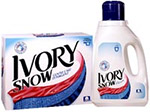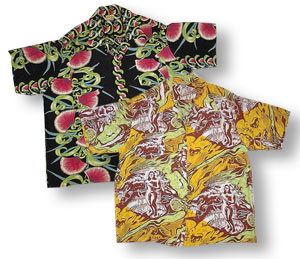|
  |  | 

Something I read many years ago and it is something to think about...
The bitterness of poor quality remains long after a cheaper price is forgotten.
It's not that the shirt or dress looks good. It's how long they look good.
 About Inventory, Stock Information, Back Orders & shopping tips About Inventory, Stock Information, Back Orders & shopping tips
|
 |
All Silk shirts are Imported.
Friendly Advice ! It is NOT advisable to wash your brightly colored apparel and Silk Shirts in your washing machine unless you are using cold water, gentle cycle and are watchful. Don't do it unless you use a the gentle cycle. You can damage your shirts and dresses if you use a washing machine on any other cycle. Do not place them in the dryer unless you stand there and remove the garments from a gentle cycle in a few moments. Line dry is best.
Two Palms, Pacific Legend, Paradise Found, Shannon Marie, Puanani, Kalaheo, Pineapple Juice and R. J. Clancey apparel are hand made. These made in Hawaii garments require proper care and consideration. With the proper care, your hand made Hawaiian clothing will give you years of comfort and enjoyment.
Some repairs can be made and seams can be re-sew if you need help. You must pay the shipping to and from Maui. There is usually no charge for this service from most manufacturers. Send us an email with a photo before you ship anything back to us.
Dry Cleaning, in most instances, will give you best results. Ask your dry cleaners if they are using a strong solution. This can be a problem, especially with red colors.
 Wash by Hand, separately or with like colors, using cold water and a very mild soap. We suggest "Ivory" soap. Do not leave the items to soak for a long time. This especially applies to white shirts with red images. If you purchase a white rayon shirt with red images Do NOT use Woolite. It will be too strong of a detergent in most instances. Wash by Hand, separately or with like colors, using cold water and a very mild soap. We suggest "Ivory" soap. Do not leave the items to soak for a long time. This especially applies to white shirts with red images. If you purchase a white rayon shirt with red images Do NOT use Woolite. It will be too strong of a detergent in most instances.
DO NOT use Bleach.
Line dry or cool dry, use a cool iron or steam to remove wrinkles.
Garments washed in hot water will lose their luster and sheen. Garments washed in HOT water WILL shrink. Rayon is made from Cotton or Wood pulp. Rayon, as well as cotton, will shink if washed in hot water.
This information is on a white tag on all garments. Please read it to prevent damage to your aloha wear. I quote here: "WASH BY HAND. COLD WATER. MILD SOAP. NO BLEACH. LINE DRY. COOL IRON ONLY.
There is no way to determine how much a garment will shrink when washed. There are too many variables; type of water, how long you keep them submerged in the water, temperature of the water, etc.
Machine washed apparel cannot be accepted for returns, exchanges, refund or replacement.
|
What is RAYON?
Rayon was the first manufactured fiber developed and made from wood or cotton pulp and was first known as artificial silk.
The Swiss chemist, Georges Audemars invented the first crude artificial silk around 1855, by dipping a needle into liquid mulberry bark pulp and gummy rubber to make threads. The method was too slow to be practical.
In 1884, a French chemist, Hilaire de Charbonnet, Comte de Chardonnay, patented an artificial silk that was a cellulose-based fabric known as Chardonnay silk. It was pretty but it was very flammable, it was removed from the market.
In 1894, British inventors, Charles Cross, Edward Bevan, and Clayton Beadle, patented a safe and practical method of making artificial silk that came to be known as viscose rayon. Avtex Fibers Incorporated first commercially produced this artificial silk known as rayon in 1910 in the United States. The actual term "RAYON" was first used in 1924.
Most buyers of our made in Hawaii quality rayon clothing appreciate that ironing is kept to a minimum if not at all. In the 60ís and 70ís rayon was a bad word. There are many, many types of rayon fabric as there are many types of cotton fabric. Rayon is manmade. It was thought to be like synthetic polyester. Even todayís polyester fabrics have improved well beyond the jump suit and bell bottom era of the 70ís. I know I place my rayon shirts into the gentle cycle of my washing machine in cold water with my usual detergent (but only a small amount, about a table spoon full). I wash each shirt separately. Then place it into the dryer for just a few minutes and then take it out and let it hang to finish drying. I never have to iron by doing it this way. I could hand wash, but that takes too long and Iíve become a bit lazy. My best friend, Adrienne, places all her rayon dresses into the washing machine and dryer the same way. She never has to do any ironing.
Mickey Steinborn, President
MauiShirts.com, Inc. |
The Shirt that says Hawai'i' - The story behind the colorful cultural icon |
Hawai'i' - awash in romance, marbled by different cultures, saturated with beauty, and compelling in contrasts - gave birth, over 50 years ago, to the renowned Aloha shirt. There is today probably no better-known garment in the world that captures a land's 'spirit of place.'
For half a century, the Aloha shirt has been Hawai'i's most enduring and visible greeter and ambassador - like the lei, the Aloha shirt is worn as a statement of one's love for, and connection to, a most special place.
These words from historian and waterman Tommy Holmes, from the forward of our book The Aloha Shirt, capture the true history of this marvelous cultural icon. The Aloha shirt, so evocative of the spirit of its home, is full of mystery and allure of Hawai'i' and the stories of those who have lived here.
Different tales have circulated for decades about the origins of the Aloha shirt. Did it spring forth late one night from the hand-operated sewing machine of a Japanese tailor? Was it inspired by the tail-out shirts of the Philippines, elegant kimono cloth from Japan, or vivid floral prints for Tahiti?
There are well-documented stores from the pre-World War II years of teenagers buying wonderful, finely printed Kabe crepe material, imported from Japan, in the dry-goods stores of downtown Honolulu. These young men had their mothers sew beautiful shirts from the fabric. That tradition of beautifully sewn printed shirts spread from the Asian dry-goods merchants and home-sewers to the tailors and dress-makers of Hawai'i', creating a new style of colorful clothing.
This all took place in the late 1920s and early 1930s, at the same time that Hawai'i' was emerging as a paradise for tourists with the building of the Royal Hawaiian Hotel in Honolulu and the christening of the trio of magnificent cruise ships by Matson navigation, opening this majestic string of island to the world. Boatloads of visitors were charmed by hula dancers swaying to the rhythm of a lone 'ukulele, enchanted by Waikiki Beach boys riding the waves on their great wooden surfboards. For those who came from afar, nothing painted a more vivid picture of Hawai'i' than these bold shirts with their vibrant island imagery.
The early Aloha shirts most often depicted ancient symbolic imagery of the Orient. Pine and plum tree prints represented long life, good fortune, and success. The images of a tiger symbolized strength and courage. Prints of bamboo denoted strength and flexibility. Early designs were also graced with traditional images of Mount Fuji, ornate temples, or peaceful landscapes.
It was not long before local artist began to design textiles that captivated the dreamy, romantic lifestyle of their island home. Early prints that were intended for home interiors soon made their way into clothing. Elsie Das designed beautiful botanical prints of native plants hibiscus, breadfruit, night-blooming cereus as well as a humorous pattern incorporating hula girls. Ethel Chun Lum designed shirts sold by her brother Ellery Chun at his store, King-Smith Clothiers. Ellery Chun was the first person to officially register the name "Aloha Shirt." Ether produced designs based on her first cruise to the mainland U.S., including flying fish seen from the deck of a Matson liner.

Garment manufacturers including Kamehameha and Branfleet (later know as Kahala), which initially produced Aloha shirts with Asian motifs in their humble factories in the mid-1930s, began to commission designs from local artists. Soon, visitors and locals alike were donning these wearable postcards awash with coconut trees, surfers, outrigger canoes, hula girls, and endless varieties of colorful tropical flowers, birds, and fish.
"Aloha shirts put Hawai'i' on the map," says renowned fabric designer John "King Keoni" Meigs. "The first thing people did when they arrived was to make a beeline for a department store to buy one."
Meigs was one of many flamboyant designers in the Gold Age of Aloha shirts, which ran from the 1930's to the 1950's. for inspiration, they shared the sunsets, beaches, flowers, and rainforests of Hawai'i'. They and their visionary colleagues - manufactures, artists, and retailers - formed the community that created this memorable art form.
Celebrities of the time - such as John Barrymore, Bing Crosby, and Elvis Presley - were widely photographed wearing the shirts. Duke Kahamamoku, Hawai'i's most beloved surfer and Olympic swimming champion, was the earliest and greatest promoter of the Aloha shirt. Duke even had his own line of shirts, which are widely coveted by collectors today.
Whether you fancy a collectible from the 1930's or a modern style of today, the Aloha shirt remains a symbol of the casual, carefree, and graceful Hawaiian lifestyle.
Reprinted from the Artful Living, The Legacy of Kukui'ula magazine, Spring, 2007.
Dale Hope and Gregory Tozian are the authors of The Aloha Shirt, (Beyone Words Publishing, 2000)
|
Got a question? Email Mickey Steinborn, President, MauiShirts.com, Inc.
Mauiman@MauiShirts.com
The images depicted on all pages of any Hawaiian shirt or Hawaiian dress is a random selection of the print. There are no two prints that are identical; every man's shirt print, boy's shirt print, girl's or women's dress print will be unique.
MauiShirts.com, Inc., Michael (Mickey) B. Steinborn reserves the right to do, or not to do, business with you.
If you attempt fraud, are abusive or rude in your communications your email address, name will be removed from our monthly email special sales. MauiShirts.com, Inc. will not tolerate rude and disrespectful people. We do business with a spirit of Aloha. We practice Aloha. We will not accept new orders from any customer if untrue, unfounded, negative remarks, feedback is posted in the Yahoo public forum. The Yahoo public forum is something we enable for you. It is there for us to improve our service to you and others. It is not there for you to make unwarranted remarks or comments.
Copyright © 2024 MauiShirts.com Inc., Michael (Mickey) B. Steinborn - Copyright © 1998 - 2024 MauiShirts.com - Copyright infringement is a civil and criminal offense.
Willful violation can result in penalties up to $ 100,000.00 per infringement. No portion of this web site, MauiShirts.com Inc.; images, photographs, text, may be reproduced by printing, photocopying or by any other means of mechanical or electronic reproduction without the express written permission from MauiShirts.com, Inc.
|





